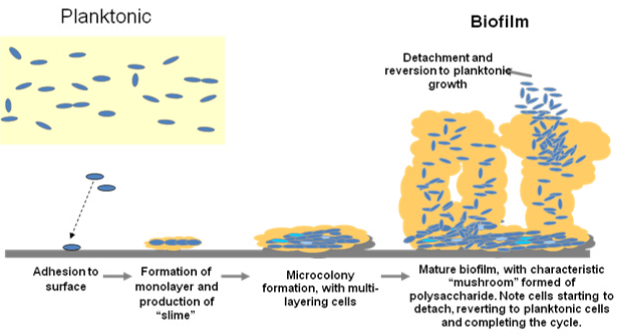Back to Basics; Biofilms
In the unseen depths of water systems, a hidden threat lurks – biofilms.
These slimy, complex communities of microorganisms cling to surfaces and pose a significant challenge to various industries, including water treatment. As we go into the world of biofilms, we’ll explore their nature, impact, and the crucial role of water treatment in combating their growth.
Understanding Biofilms
Biofilms are intricate communities of microorganisms that adhere to surfaces and form slimy, protective matrices. They consist of bacteria, fungi, algae, and other microorganisms, which secrete a sticky substance called extracellular polymeric substance (EPS). This EPS acts as a shield, safeguarding the biofilm inhabitants from external threats such as disinfectants, antibiotics, and immune responses.
The Formation and Growth of Biofilms
Biofilm formation begins when individual microorganisms attach to a surface. They then multiply and start secreting EPS, creating a protective environment. As the biofilm matures, more microorganisms join, resulting in a complex structure with channels for nutrient and waste exchange. This intricate network allows microorganisms to communicate, further enhancing their resilience and resistance to eradication.

Impacts of Biofilms
Biofilms can wreak havoc in various industries, especially in water systems. Here are some of the significant impacts they have:
- Reduced Efficiency: Biofilms act as insulators, reducing the heat transfer efficiency in heat exchangers and cooling towers. This decreases the overall performance and energy efficiency of industrial processes.
- Contaminant Retention: Biofilms can trap and accumulate heavy metals, organic compounds, and pathogens, posing a significant risk to human health and the environment. These contaminants can be released back into the water, leading to further contamination.
- Corrosion and Infrastructure Damage: Biofilms produce acidic metabolic byproducts that corrode pipes, equipment, and infrastructure. This corrosion not only compromises the structural integrity of these systems but also leads to expensive repairs and replacements.
- Treatment Challenges: Biofilms are highly resistant to conventional disinfection methods. They can protect pathogens from being effectively eliminated, increasing the risk of waterborne diseases.
The Role of Water Treatment
Water treatment plays a critical role in the battle against biofilms. It aims to prevent the formation of biofilms, remove existing biofilms, and maintain water quality.
Here’s why effective water treatment is essential:
Prevention: Proper water treatment involves implementing measures to minimize biofilm formation. This includes pre-treatment processes like filtration, which removes suspended particles that serve as attachment sites for microorganisms. Additionally, the control of water chemistry, temperature, and flow helps deter biofilm formation.
Disinfection: Water treatment facilities employ disinfection methods such as chlorination, ozonation, or UV irradiation to eliminate microorganisms, including those protected within biofilms. These processes disrupt biofilm structure and kill or inhibit the growth of bacteria and other microorganisms.
Monitoring and Control: Regular monitoring of water quality, including biofilm-related parameters, enables early detection and effective control measures. Analyzing biofilm growth patterns, microbial activity, and nutrient levels aids in adjusting treatment strategies for optimal results.
Maintenance and Cleaning: Water treatment facilities must conduct regular maintenance and cleaning procedures to remove accumulated biofilms. Physical cleaning methods like brushing, high-pressure water jets, and chemical cleaning agents can help dislodge and eradicate biofilms from surfaces.
Conclusion
Biofilms are persistent adversaries that thrive in water systems and pose numerous challenges. However, with effective water treatment strategies, we can combat their growth and minimize their detrimental impacts. Preventive measures, disinfection techniques, vigilant monitoring






